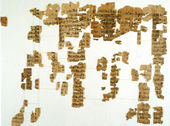
© Museo Egizio, Torino For 100 years, archaeologists have been trying to piece together fragments to this 3,000-year-old document, written on a papyrus stem. The Egyptian document enumerates all the Egyptian kings and when they ruled. Newly found fragments to the document should help in piecing together the puzzle.
Some newly recovered papyrus fragments may finally help solve a century-old puzzle, shedding new light on ancient Egyptian history.
Found stored between two sheets of glass in the basement of the Museo Egizio in Turin, the fragments belong to a 3,000-year-old unique document, known as the Turin Kinglist.
Like many ancient Egyptian documents, the Turin Kinglist is written on the stem of a papyrus plant.
Believed to date from the long reign of Ramesses II, the papyrus contains an ancient list of Egyptian kings.


